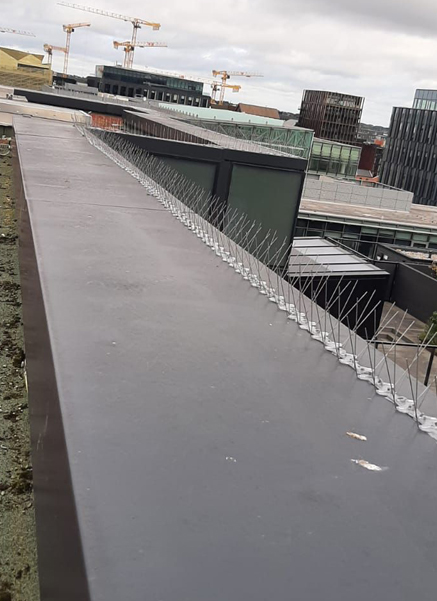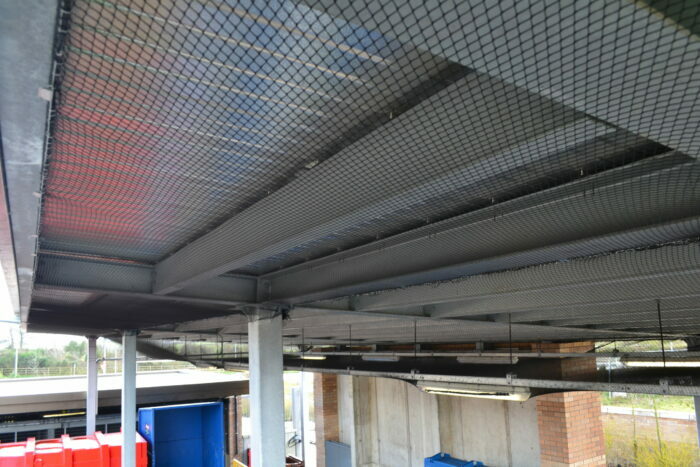Bird Control

Bird Pest Control
Pigeons and seagulls can be a real threat to your business; bird fouling is not only unsightly is also causes corrosive damage to roof tiles, buildings and machinery, while nesting materials can block guttering. There is also the threat of secondary infestations from lice, mites and flies and health-related problems such as cryptococcosis, histoplasmosis and psittacosis which are caused by bird droppings.
Our experienced avian specialists are cognisant of the many non-target species amongst our urban and rural wildlife and have extensive experience dealing with birds including seagulls, pigeons, crows and starlings.
We have worked on complex sites like rail platforms, power stations, petrol stations, and chemical plants in addition to retail sites and office blocks. Our specialist team will carry out a detailed survey of your site with recommendation on suitable proofing systems or a combination of possible solutions. Our surveyor will ensure that your premises is protected from unwanted birds but will work to ensure that access and the aesthetics of your property remain unaffected.
Reduction or the removal of food sources
Removal of roosting sites
Where possible windowsills and any other feature that might provide roosting sites for birds should be removed at the design stage, particularly in places where there are already bird control issues such as coastal areas.
A roof should be designed and detailed specifically to exclude birds by keeping all gaps and openings below 20mm. An angle of 45 degrees or more will prevent birds from roosting. In all instances however without the prescience the upkeep of buildings should always be a priority to keep birds invading this space. Issues such as missing rooftiles, broken windows, inlets / damage to the fabric of the building should be addressed immediately .
Proofing against bird nesting and roosting
Proofing measures such as netting and stainless-steel spikes can be used to deter birds from roosting on buildings. Netting mesh sizes for bird proofing will vary according to the species of bird and our experts can advise you what is the correct choice to protect your premises. Spike systems will deter birds from roosting on ledges that cannot be made inaccessible by netting. For maximum effectiveness they need to be fixed to ensure that the ledge is adequately covered by the spikes. Installation can be arranged by our expert avian team, we can also be available to offer advice to your chosen contractor.
Bird Netting
Netting is one of the most common and successful methods of bird control, our team can ensure that vulnerable areas are covered in netting to protect them . Nets can cover small vulnerable areas or features or if required entire elevations of buildings.
Point systems
Point systems have pointed spikes or wires that deter birds from landing, they come in a range of different styles to suit different situations. Point systems are only useful against pigeons, heavier duty versions can be sourced for seagulls if required.
Bird Wire Systems
Bird wire systems consist of thin, stainless-steel wire that is tensioned by a spring and used to prevent pigeons and gulls from landing on ledges, gutters or pipes.
Shooting
Lethal control is also an option when a bird has entered a food premises or overcome the proofing measures. We have certified marksmen as part of our specialist team
Repellent and Scaring devices
Scaring techniques rarely work with pigeons, visual and audio scaring also tend to be unsuccessful and even in the cases where it works the success can be short-lived. Pigeons adapt very quickly to new things.
Repellents are normally chemical substances that offend the birds sense of taste or smell. Scaring devices frighten birds by acting on the birds visual / audio senses, a scarecrow of the skies as it were.
Birds of Prey can be useful but are not suitable for all environments.
Have you got a pest problem?
Call us today on 028 7940 1261
Gulls
Gulls are members of a large, widespread family of seabirds generally identified as seagulls although there is no species actually called a seagull. Gulls are intelligent, adaptable, beautiful birds but be careful not to feed them or they will be happy to steal your lunch! In Ireland all gulls and their active nests are protected by National and European Wildlife Legislation/Directives.
The main gulls found in Ireland are:
- The Herring gull / Larus argentatus
- The Lesser black-backed gull / Larus fuscus
Behaviour of gulls
Opportunist gulls make their nest on buildings, and regularly feed from refuse tips, particularly in the winter. They fly huge distances for food, which they often find at landfill sites, sewage outlets, agricultural land, and by scavenging from urban areas. During the winter, neighbouring gulls from Europe and further afield migrate to the UK.

Biology of gulls
Once a breeding site is chosen, gulls will usually return to it every year, they begin breeding when they are around five years old and have a lifespan of up to 25 years!
Eggs are laid in April and May, with up to three eggs being laid per season. The eggs hatch after around 30 days, and only 10 days after that, they can take their first flight.
Pigeons
Wood Pigeon /Columba palumbus.
The Wood Pigeon is the largest of the pigeons in Ireland with a proportionally long tail and small head. A full breast. Easily identified in flight by large white wing bands traversing the upper wing. White and green patches on the side of the neck. In the breeding season they are conspicuous in upward-soaring display flights which end in wing clapping.
Behaviour of a pigeon
You’ll often see pigeons in town centres feeding in huge flocks, ranging in size from 50 to 400-plus birds. Pigeons have a social order, so the more dominant birds feed first and get the best breeding sites.
Biology of a pigeon
Feral pigeons originally descended from domesticated rock doves. The population is supported by escaped racing pigeons. Pigeons usually make their nests in bridges, buildings or any structures with easily accessible shelter. Males and females help build nests out of grass, twigs, features and even litter such as plastics and wire. The nests can be quite large and quickly become thick with droppings.
Depending on breeding conditions, pigeons can have up to seven broods (birds produced at one hatching) in their breeding season between March and July. Two eggs hatch in around 18 days. With access to enough food, the young pigeons will become independent adults in just 30 days. More eggs can be hatched before the young have even left the nest, meaning a population can quickly grow. Wild pigeons will live up to four years, relying on human food scraps and spillages, or taking from newly sown farmland.
Legislation
Unlike other pest species, birds have legislative protection, which can only be reviewed if evidence can be shown that their presence is detrimental to man in some way.
Under the Wildlife Act 1976, all wild birds, their eggs, nests and habitat are protected, however EU member states may derogate from the provisions in the directive, where there is no other satisfactory solution, for the following reasons:
- In the interests of public health and safety
- In the interest of air safety
- To prevent serious damage to crops, livestock, forests, fisheries and water
- For the protection of flora and fauna
